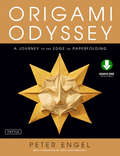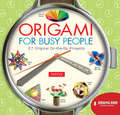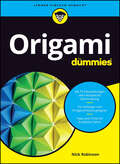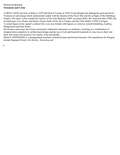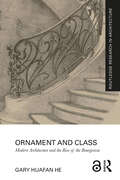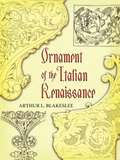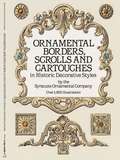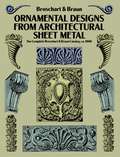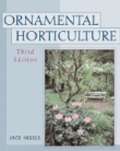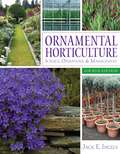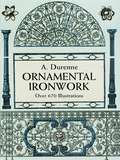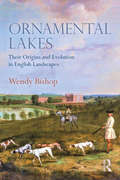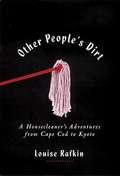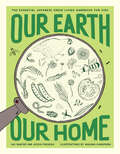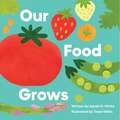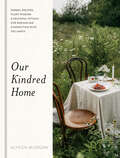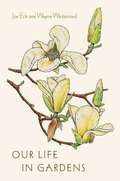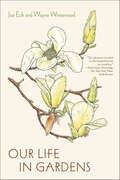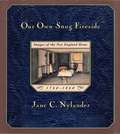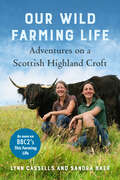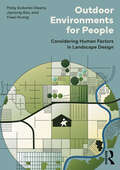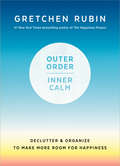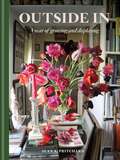- Table View
- List View
Origami Odyssey
by Peter EngelRenowned origami artist Peter Engel first astounded origami enthusiasts and the lay person alike with his popular Origami from Angelfish to Zen. Since that book, published in 1989, Engel has gone through a personal change in his philosophy of origami design, honed through decades of elevating what is often viewed as simple paper folding into a fine art. In Origami Odyssey, Engel takes paper crafters on a journey to the edge of paper folding, providing instruction for exquisite and original origami designs, including several that have been shown in galleries and museums throughout the world. Experienced folders will delight in the chance to grow as artists as they master the projects in this book, and new comers to origami will find the author's journey so inspiring that they'll be ready to begin an odyssey of their own. This unique do-it-yourself paper craft book includes:Full-colored photos and step-by-step instructions and diagrams21 fun-to-do projects like the Green Horned Owl, Gingko Leaf, Stingray and much more!An instructional DVD with easy-to-follow video tutorials
Origami for Busy People
by Marcia Joy MillerTurn a crazy, hectic work day around in just a few minutes with Origami for Busy People. Before jumping from one project to another, a little mental relaxation comes in handy to rejuvenate and revive the brain. This fun little book provides a variety of shorter and longer projects that can be completed during a coffee break, over lunch, or whenever a mini vacation is required.Projects include: Duck Glider Ghost Trigon Reversible StarSpring Flower Fluted Vase Starry SkyBasic folding techniques, color photos of the 27 projects and 48 tear-out folding sheets combine to make this handy book a new workplace favorite!
Origami für Dummies (Für Dummies)
by Nick RobinsonMehr als nur Papiertiger Wollten Sie schon immer die uralte Kunst des Origami meistern? Dann ist dieses Buch genau das Richtige für Sie. Verständliche Schritt-für-Schritt-Anleitungen, bestehend aus Abbildungen und begleitendem Text, helfen Ihnen dabei, ein langweiliges Stück Papier in die verschiedensten Origami-Modelle zu verwandeln. Egal ob Anfänger oder Fortgeschrittener - für jeden ist das richtige dabei. Dabei gibt der Autor auch allgemeine Tipps zur perfekten Faltung, zum Erstellen eigener Modelle und verrät, was zu tun ist, wenn Sie mal nicht weiterwissen. So werden auch Sie zum Origami-Meister. Sie erfahren Wie Sie Grundformen falten und Papier einteilen Wie Sie neue Origami-Modelle entwerfen Wie Sie auch knifflige Modelle meistern Wie Sie mithilfe von Origami Spinnen lebend aus Ihrer Wohnung entfernen
Ornament And Crime
by Adolf LoosAdolf Loos, the great Viennese pioneer of modern architecture, was a hater of the fake, the fussy and the lavishly decorated, and a lover of stripped down, clean simplicity. He was also a writer of effervescent, caustic wit, as shown in this selection of essays on all aspects of design and aesthetics, from cities to glassware, furniture to footwear, architectural training to why 'the lack of ornament is a sign of intellectual power'.
Ornament and Class: Modern Architecture and the Rise of the Bourgeoisie (Routledge Research in Architecture)
by Gary Huafan HeThis groundbreaking study examines the intricate relationship between the rise of the nineteenth-century bourgeoisie and the emergence of modern architecture, exploring this connection through major intellectual and theoretical works while also analyzing their tangible manifestations in buildings and architectural projects.Contrary to received narratives that describe the birth of modern architecture as primarily an aesthetic movement, Ornament and Class argues that the social and political maturation of the European bourgeoisie as a distinct-yet-heterogeneous group influenced modern attitudes toward architecture at every level. Bringing architecture into conversation with recent histories of the bourgeoisie in the social sciences, the book considers how architecture was used as a tool to separate the modern bourgeoisie from the aristocratic and clerical forces above and the working classes below. It explores how architects, clients, planners, and administrators grappled with and dealt with ornament, architecture, and modernity from within the new realities of urban and global capitalism, and shows how these realities serve as pedagogical touchstones that remain with us today.Historians, architecture scholars, and students interested in modern architecture, aesthetics, and European history, especially those focusing on the interplay between modern architecture and social development, will find this book an invaluable resource.
Ornament of the Italian Renaissance
by Arthur L. BlakesleeThis glorious gallery of stunning architectural accents from Italy's Middle Ages has been assembled from a rare, early-twentieth-century publication: * Grotesques from carved panels of choir stalls* Breathtaking tombstone and ceiling ornaments * Sumptuous stone balcony panels... and much more, all reproduced in sixty richly detailed illustrations. Designers and artists of every variety will revel in this modestly priced treasury of authentic Renaissance style.
Ornamental Borders, Scrolls and Cartouches in Historic Decorative Styles (Dover Pictorial Archive)
by Syracuse Ornamental Co.Hundreds of beautiful copyright-free line illustrations of intricately carved furniture trimmings. Delicate floral wreaths, scrolls, more.
Ornamental Designs from Architectural Sheet Metal: The Complete Broschart & Braun Catalog, ca. 1900 (Dover Pictorial Archive)
by Wm. A. Braun Jacob BroschartA must for architectural historians, restoration specialists and vintage home enthusiasts: 1,095 late Victorian-era designs, superbly drawn or photographed, including egg and dart enrichments; bead, flute and ogee enrichments; drapery and drop ornaments; urns, vases and wreaths; eagles, lion heads and gargoyles; rosettes, ribbons, garlands and festoons; sunbursts, weather vanes and more.
Ornamental Horticulture: Science, Operations, and Management (3rd edition)
by Jack E. IngelsThis comprehensive text introduces students to both the art and science of ornamental horticulture. The book includes equal coverage of such diverse topics as science, crop production, craftsmanship, and business management skills. From this balanced perspective, the student gains an appreciation for the value of the diverse segments of ornamental horticulture. In addition, the text offers students a realistic view of the business skills required to be successful in ornamental horticulture. Such pedagogical features as extensive illustrations, objectives, and review questions help students monitor their progress. This unique text gives students a well-rounded view of both the art and science of ornamental horticulture to prepare them for careers in this exciting industry.
Ornamental Horticulture: Science, Operations, and Management (4th edition)
by Jack E. IngelsThis comprehensive book is an ideal introduction for both hobbyists and professionals to the art and science of ornamental horticulture providing a balanced coverage of the diverse elements integral to this exciting field and a realistic view of the required business skills while also giving them the chance to develop their creativity.
Ornamental Ironwork: Over 670 Illustrations (Dover Pictorial Archive)
by A. DurenneFinely detailed illustrations, selected from rare turn-of-the-century sources, provide striking examples of decorative ironwork designed to embellish balconies, gates, window grilles, staircases, doorways, and other architectural features. A rich source of inspiration and elegant, royalty-free material for graphic artists, designers, and craftworkers.
Ornamental Lakes: Their Origins and Evolution in English Landscapes
by Wendy BishopOrnamental Lakes traces the history of lakes in England, from their appearance in the early eighteenth century, through their development in the 1750s, and finally to their decline in the nineteenth century. Aside from the natural lakes in the Lake District, the bodies of water we see in England today are man-made, primarily intended to ornament the landscapes of the upper classes. Through detailed research, author Wendy Bishop argues that, contrary to accepted thinking, the development of lakes led to the dissolution of formal landscapes rather than following changes in landscape design. Providing a comprehensive overview of lakes in England, including data on who made these lakes, how, and when, it additionally covers fishponds, water gardens, cascades and reservoirs. Richly illustrated and accompanied by case studies across the region, this book offers new insights in landscape history for students, researchers and those interested in how landscapes evolve.
Other People's Dirt: A Housecleaner's Curious Adventures
by Louise RafkinEntertaining stories of house cleaning
Our Earth, Our Home: Have Fun and Live Sustainably!
by Kai Sawyer Azusa FukuokaBeautifully illustrated, energetic guide from Japan for forward-thinking kids and parents on how to live in harmony with our earth—contains sections on DIY crafts, design thinking, mindfulness, gardening, eating, permaculture, and moreYoung readers will be swept along by Kai, the guide on this journey, who only has five rules:1) Be yourself2) You have everything you need3) You can create whatever you want4) We are all connected5) Have fun with life! With those rules as the north star, Ranger Kai teaches kids and adults about eating, permaculture, mindfulness, design thinking, creating a garden, DIY crafts, and more. Each section includes illustrated step-by-step guides and activity ideas. Many books on climate change and green living for kids focus on recycling or other small-picture ideas. This book from Japan dares to truly envision a post-carbon future—and not only that, embraces it and charts the path towards a truly fun life, in harmony with the Earth.
Our Food Grows
by Sarah M. WhiteWhen you&’re a kid, it&’s hard to know where food comes from—it usually just shows up! In this tasty, educational seed-to-table journey, kids will explore how favorite foods like strawberries, tomatoes, asparagus, and corn grow.With vibrant illustrations and simple explanations, Our Food Grows shows how fruits, vegetables, and grains make their way from the farm to our plates. Perfect for curious kids and budding gardeners, this engaging introduction to where our food comes from reveals the magic of growing your own garden.Whether you're teaching children about healthy eating or inspiring them to get their hands dirty in the garden, this book is a delightful way to spark their interest in the natural world and the food they eat.• An Early Food Education—Simple, easy-to-understand explanations of how food grows and gets to the table. • Connect with the Environment—Bright, collage-based illustrations help children understand and respect the natural world around them. • Develop Healthy Eating for Life—Create positive attitudes towards food at an early age to establish lifelong healthy eating habits.Help kids explore the roots of their favorite foods with this gentle, beautifully illustrated book about how food grows and the pleasures of healthy eating.
Our Kindred Home: Herbal Recipes, Plant Wisdom, and Seasonal Rituals for Rekindling Connection with the Earth
by Alyson MorganLearn to reconnect with plants and nature for collective healing in a world beset by environmental crisis with this herbalism and eco-activist handbook.&“Breathtakingly beautiful . . . a gentle and welcoming hand offering to guide those of us seeking mindful connection and mutually nurturing paths through life in the Anthropocene.&”—Whitney Leigh Morris, author of Small Space StyleAlyson Morgan, a second-generation Haitian American, grew up feeling disconnected from her roots and suffering from the trauma of racism. To heal herself, she found a connection with the natural world around her: slowing down, respecting the seasons, and growing or foraging plants in her local area. To Alyson, connection with the earth means finding a sense of place and home in an era of stress and overwhelm. Now she shares her methods of homesteading for anyone to practice in their own life. Beautifully photographed, with plant monographs, illustrations, and recipes, Our Kindred Home explores our deep ties to the natural world and offers regenerative and sustainable ways of living. Alyson helps readers better understand the deep grief and systemic harm that stems from disconnection with nature, and provides pathways for healing, such as: • An exploration of ecological grief and its impacts• Information for working with subtle body energy• Tools for observing, identifying, foraging, and cultivating plants• Methods for creating infusions, honeys, vinegars, and oils• More than 80 seasonal and 40 plant monographsWith the whole world in environmental crisis, creating a relationship with the earth that is reciprocal rather than exploitative and understanding our fundamental interconnectedness is more vital than ever. In Our Kindred Home, you'll find everyday ways to connect to the earth for resilience, resistance, liberation, and collective healing.
Our Life In Gardens
by Joe Eck Wayne WinterrowdTwo renowned garden designers present this entertaining, fascinating, and unexpectedly moving book about the life and garden they share. The book also contains much sound information about the cultivation of plants and their value in the landscape.
Our Life in Gardens
by Joe Eck Wayne WinterrowdThis is the third book we have written together, though separately we have written others . . . But to say ‘written separately' makes no sense, for when two lives have been bent for so many years on one central enterprise—in this case, gardening—there really is no such thing as separately." With these words, the renowned garden designers Joe Eck and Wayne Winterrowd begin their entertaining, fascinating, and unexpectedly moving book about the life and garden they share. The book contains much sound information about the cultivation of plants and their value in the landscape, and invaluable advice about Eck and Winterrowd's area of expertise: garden design. There are chapters about the various parts of their garden, and sections about particular plants—roses and lilacs, snowdrops and cyclamen—and vegetables. The authors also discuss the development of their garden over time, and the dark issue that weighs more and more on their minds: its eventual decline and demise. Our Life in Gardens is a deeply satisfying perspective on gardening, and on life.
Our Own Snug Fireside: Images of the New England Home, 1760-1860
by Jane NylanderThis charming book portrays domestic life in New England during the century between the American Revolution and the Civil War. Drawing on diaries, letters, wills, newspapers, and other sources, Jane C. Nylander provides intimate details about preparing dinner, spinning and weaving textiles, washing and ironing laundry, planning a social outing, and exchanging food and services. Probing behind the many myths that have grown up about this era, Nylander reveals the complex reality of everyday life in old New England.
Our Wild Farming Life: Adventures on a Scottish Highland Croft
by Lynn Cassells Sandra BaerAs seen on the BBC’s This Farming Life The inspirational story of Lynbreck Croft—a regenerative Scottish farm rooted in local food, community, and the dreams of two women. "A ripping good account of the guts, luck and perseverance it takes to create a productive and healthy farm or croft that jumps the rails of our conventional industrial agriculture."—Nick Offerman, New York Times bestselling author of Where the Deer and the Antelope Play "I raced through this beautiful story with mounting awe and excitement. . . . Pragmatism, honesty and openness to new and old ideas shines through on every page. I hope it inspires legions of new farmers."—Isabella Tree, author of Wilding Lynn and Sandra left their friends, family, and jobs in England to travel north to Scotland to find a bit of land that they could call their own. They had in mind keeping a few chickens, a kitchen garden, and renting out some camping space; instead, they fell in love with Lynbreck Croft—150 acres of opportunity and beauty, shrouded by the Cairngorms and deep in the Highlands of Scotland. But they had no money, no plan, and no experience in farming. In Our Wild Farming Life, Lynn and Sandra recount their experiences as they rebuild their new home and work out what kind of farmers they want to be. They learn how to work with Highland cattle, become part of the crofting community and begin to truly understand how they can farm in harmony with nature to produce wonderful food for themselves and the people around them. Through efforts like these, Lynn and Sandra have been able to combine regenerative farming practices with old crofting traditions to keep their own personal values intact. Our Wild Farming Life is what happens when you follow your dreams of living on the land; a story of how two people became farmers—and how they learned to make a living from it, their way. "[This] is a warm yet realistic chronicle of the world of the small-time farmer, sharing a vision of how we humans can feed ourselves sustainably and ethically while living in harmony with the natural world."—Booklist "For anyone who has ever sat in a city office dreaming of . . . living off the land, this book will inspire them to take the plunge."—The Telegraph
Our Wild Farming Life: Adventures on a Scottish Highland Croft
by Lynn Cassells Sandra BaerAs seen on the BBC&’s This Farming LifeThe inspirational story of Lynbreck Croft—a regenerative Scottish farm rooted in local food, community, and the dreams of two women."A ripping good account of the guts, luck and perseverance it takes to create a productive and healthy farm or croft that jumps the rails of our conventional industrial agriculture."—Nick Offerman, New York Times bestselling author of Where the Deer and the Antelope Play"I raced through this beautiful story with mounting awe and excitement. . . . Pragmatism, honesty and openness to new and old ideas shines through on every page. I hope it inspires legions of new farmers."—Isabella Tree, author of WildingLynn and Sandra left their friends, family, and jobs in England to travel north to Scotland to find a bit of land that they could call their own. They had in mind keeping a few chickens, a kitchen garden, and renting out some camping space; instead, they fell in love with Lynbreck Croft—150 acres of opportunity and beauty, shrouded by the Cairngorms and deep in the Highlands of Scotland.But they had no money, no plan, and no experience in farming.In Our Wild Farming Life, Lynn and Sandra recount their experiences as they rebuild their new home and work out what kind of farmers they want to be. They learn how to work with Highland cattle, become part of the crofting community and begin to truly understand how they can farm in harmony with nature to produce wonderful food for themselves and the people around them. Through efforts like these, Lynn and Sandra have been able to combine regenerative farming practices with old crofting traditions to keep their own personal values intact.Our Wild Farming Life is what happens when you follow your dreams of living on the land; a story of how two people became farmers—and how they learned to make a living from it, their way."[This] is a warm yet realistic chronicle of the world of the small-time farmer, sharing a vision of how we humans can feed ourselves sustainably and ethically while living in harmony with the natural world."—Booklist"For anyone who has ever sat in a city office dreaming of . . . living off the land, this book will inspire them to take the plunge."—The Telegraph
Outdoor Environments for People: Considering Human Factors in Landscape Design
by Patsy Eubanks Owens Jayoung Koo Yiwei HuangOutdoor Environments for People addresses the everyday human behavior in outdoor built environments and explains how designers can learn about and incorporate their knowledge into places they help to create. Bridging research and practice, and drawing from disciplines such as environmental psychology, cultural geography, and sociology, the book provides an overview of theories, such as personal space, territoriality, privacy, and place attachment, that are explored in the context of outdoor environments and, in particular, the landscape architecture profession. Authors share the impact that place design can have on individuals and communities with regard to health, safety, and belonging. Beautifully designed and highly illustrated in full color, this book presents analysis, community engagement, and design processes for understanding and incorporating the social and psychological influences of an environment and discusses examples of outdoor place design that skillfully respond to human factors. As a textbook for landscape architecture students and a reference for practitioners, it includes chapters addressing different realms of people–place relationships, examples of theoretical applications, case studies, and exercises that can be incorporated into any number of design courses. Contemporary design examples, organized by place type and illustrating key human factor principles, provide valuable guidance and suggestions. Outdoor Environments for People is a must-have resource for students, instructors, and professionals within landscape architecture and the surrounding disciplines.
Outer Order, Inner Calm: Declutter and Organize to Make More Room for Happiness
by Gretchen RubinFor most of us, outer order contributes to inner calm. And for most of us, a rigid, one-size-fits-all solution doesn't work. The fact is, when we tailor our approach to suit our own particular challenges and habits, we're then able to create the order that will make our lives happier, healthier, more productive, and more creative. Gretchen Rubin has found that getting control of our stuff makes us feel more in control of our lives. By getting rid of things we don't use, don't need, or don't love, we free our minds (and our shelves) for what we truly value. With a sense of fun, and a clear idea of what's realistic for most people, Gretchen Rubin suggests dozens of manageable steps for creating a more serene, orderly environment—one that helps us to create the lives we want.
Outside In: A Year of Growing & Displaying
by Sean A Pritchard'Inventive, considered, and thoughtful design.' House & GardenIn his debut book, garden designer Sean A Pritchard shows you how to plan a garden so that every month of the year there's something to bring indoors and display in an engaging way. From the cheery joy of early spring daffodils to the velvety richness of late-summer dahlias, the deep glow of golden autumn leaves to the optimism of late-winter catkins, Sean explains how to grow, harvest, and arrange an abundance of nature's treasure - no matter the size of your plot or your level of horticultural experience.
Outside In: A Year of Growing & Displaying
by Sean A Pritchard'Inventive, considered, and thoughtful design.' House & GardenIn his debut book, garden designer Sean A Pritchard shows you how to plan a garden so that every month of the year there's something to bring indoors and display in an engaging way. From the cheery joy of early spring daffodils to the velvety richness of late-summer dahlias, the deep glow of golden autumn leaves to the optimism of late-winter catkins, Sean explains how to grow, harvest, and arrange an abundance of nature's treasure - no matter the size of your plot or your level of horticultural experience.
